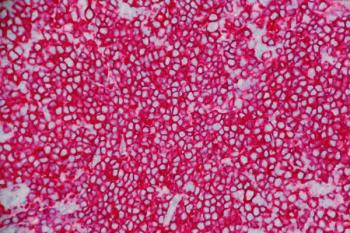
Cancer in HIV-Positive Population Expected to Decline by 2030
Decline in cancer incidence rates most likely driven by modern antiretroviral therapies.
HIV-associated cancers are expected to decline by 2030, with the biggest drivers attributed to decreasing rates of
The investigators sought to estimate future cancer risk and burden among individuals with HIV using age-specific cancer incidence data from the NCI HIV/AIDS Cancer Match study from 2000 to 2012. They then projected HIV prevalence data from the CDC.
Poisson regression was used to estimate incidence rates among HIV-positive patients divided by age and risk group for certain cancers between 2013 and 2030.
The investigators estimated that total cancer burden among individuals living with HIV will decrease from 7908 cases in 2010 to 6495 cases by 2030, based on the significant decreases in Kaposi sarcoma, non-Hodgkin lymphoma, and cervical cancer (2719 in 2010 versus 701 in 2030).
“Declines in cancer incidence rates, particularly AIDS—–defining cancers, are likely driven by widespread treatment with modern antiretroviral therapies, which reduce immune suppression and decrease risk for some cancers,” investigator Jessica Y. Islam, MPH, said in a press release.
The authors noted that although HIV-associated cancer is expected to decline, they expect a small increase in all non-AIDS-defining cancers (5190 versus 5794).
Based on declines from 2000 to 2012, age-specific cancer incidence rates are expected to decrease across age groups for cervical cancer, lung cancer, and non-Hodgkin lymphoma, according to the study. Decreases are also expected among some age groups for Kaposi sarcoma, colon cancer, and Hodgkin lymphoma.
Prostate cancer rates are projected to increase, the authors found. All other age-specific cancer rates are not expected to significantly change.
In 2010, the most common cancers for this patient population were Kaposi sarcoma and non-Hodgkin lymphoma. In 2030, the most common cancers are projected to be anal, lung, liver, and prostate.
The authors noted that the number of individuals with HIV who are 65 years or older are expected to increase to 21.4% in 2030 in the United States.
“It is crucial to understand both incidence rates and burden over times, as rates capture changes in risk, and burden quantifies the actual number of cancer cases expected to occur … lung cancer rates are expected to decrease in the future, but the burden is expected to increase due to the growing number of older people living with HIV,” investigator Meredith S. Shiels, PhD, said in a release.
The findings were presented at the American Association for Cancer Research annual meeting.
Newsletter
Stay informed on drug updates, treatment guidelines, and pharmacy practice trends—subscribe to Pharmacy Times for weekly clinical insights.














































































































































































































